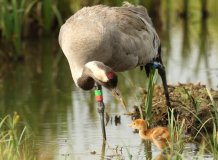
Cranes start to breed when they’re about four years old
Cranes here to stay, new model predicts
The UK’s tallest bird – the common crane – is here to stay and we could have as many as 275 breeding pairs within 50 years, according to the latest population model from scientists at the University of Exeter, WWT and RSPB published in Animal Conservation.
Cranes recolonised the East of England in 1979 after being extinct in the UK for 400 years. Since then conservationists have done what they can to support the small population.
However, cranes breed slowly and for the next two decades their numbers remained low, leaving them at continued risk of a second extinction.
According to the new population model, an important part of the growth was due to new arrivals from continental Europe until 2010, when conservationists started to import eggs and release fledgling cranes in the West of England as part of the Great Crane Project.
By 2014 the Great Crane Project had reinforced the UK crane population with 90 new birds. According to the model, the result is likely to be an increase of 50% in the number of breeding cranes we can expect in the UK in 50 years’ time.
Dr Andrea Soriano-Redondo, of the Centre for Ecology and Conservation on the University of Exeter’s Penryn Campus in Cornwall, led the research as part of her PhD.
“Any small and newly established group is particularly vulnerable to random events such as an outbreak of disease,” she said.
“Knowing how many there are isn’t enough to predict whether they’re safe.
“Understanding the interplay between new arrivals, births and deaths enables us to judge the risks they face and predict their future with far more certainty.”
Cranes start to breed when they’re about four years old. They can live for 30 years or more, but even in a successful breeding season they only rear one or two chicks.
Professor Stuart Bearhop, of the University of Exeter, said: “Of course it is obvious that adding birds will boost the population size, but what we find here is that these additional birds, as they establish themselves and become breeders, are a key element in the future persistence of this charismatic species in the UK.”
Wildlife translocations such as the Great Crane Project, where eggs or young are moved from a healthy population to reinforce another elsewhere, have in the past been characterised as expensive and risky.
Dr Geoff Hilton, WWT’s Head of Conservation Science, said: “Previously, cost and uncertainty have put some conservationists off these type of interventions.
“However, delving deeper into the numbers for cranes shows that, in combination with good habitat management and protection, we can greatly accelerate the recovery of some of our most special wildlife, allowing more people to enjoy them more quickly.”
The future for cranes in the UK now looks positive thanks to the efforts of the UK Crane Working Group, the Great Crane Project and other dedicated conservationists. Cranes are now a regular sight in the east of England, Somerset and Gloucestershire.
The next challenge is to ensure there is enough suitable wetland available for them to breed safely. Conservationists are looking to restore whole landscapes, so that areas of habitat are more, bigger, better and joined up, which will benefit cranes and other species.
Andrew Stanbury, RSPB Conservation Scientist, said: “It is always great to get the opportunity to celebrate a real conservation success story and UK cranes is one of these.
“Thanks to a successful conservation partnership we are welcoming a charismatic species back in our countryside following a 400-year absence.”
Date: 17 July 2018
